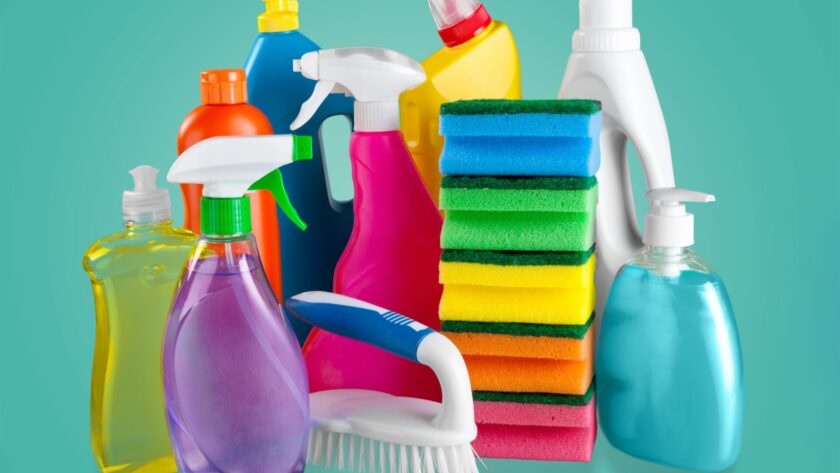As the health-conscious trend gains momentum, many individuals meticulously scrutinize product labels, avoiding the inclusion of toxic substances and potentially harmful compounds. Yet, amidst the quest for chemical-free living, there is a group of compounds that holds a space in most American homes, often without the knowledge of even the most vigilant consumers.
These compounds, known as quaternary ammonium compounds or “quats,” are deeply entrenched in various cleaning agents, disinfectants, and personal care items.
Despite their wide usage and seemingly innocuous presence, a growing body of research and public discourse is shedding light on the potential risks associated with quats.
In this article, we delve into the world of quats, exploring their prevalence, functions, and the debates surrounding their safety, to unravel the enigma behind these ubiquitous yet controversial household chemicals.
The Common Yet Controversial Household Chemicals
Ammonium quaternary compounds, more commonly known as “quats,” have silently infiltrated nearly every American household, concealed within an array of cleaning products and disinfectants. From disinfectant sprays to toilet cleaners, these versatile compounds have become a staple in our daily cleaning routines.
So much so that they are even registered as pesticides by the Environmental Protection Agency (EPA), earning a place as the “active ingredients” on the labels of various disinfectant products.
The Potential Harms of Ammonium Quaternary Compounds:
While their effectiveness in eliminating harmful microbes from surfaces is well-documented, recent research is raising concerns about the potential health and environmental risks associated with quats. As powerful irritants, quats can wreak havoc on our skin, leading to dermatitis and rashes upon contact.
Inhalation of quats-laden air can further aggravate the lungs, sparking worries regarding their role in respiratory conditions. Studies involving farmers exposed to disinfectants containing specific quats have indicated a correlation between such exposure and chronic respiratory issues, as well as reduced lung function.
Astonishingly, quats have been identified as triggers for work-related asthma in cleaning workers, accentuating their potential impact on respiratory health.
Beyond Irritation: Reproductive Health and Environmental Concerns:
Emerging research also casts a shadow over quats’ influence on reproductive health. A study involving mice highlighted a stark decline in fertility and an increase in birth defects among mice exposed to disinfectants containing quats.
Alarming even more, it took several months to eradicate the residual quats on the cages after switching to an alternative cleaner. Subsequent studies further linked quats to adverse reproductive effects in both male and female mice, manifesting as lowered sperm concentrations, disrupted sperm motility, decreased fertility, and disrupted ovulation.
Moreover, quats have been associated with neural tube defects in the offspring of exposed mice.
Quats in the Environment: A Growing Concern:
As quats are released into the environment through the widespread use of cleaning products, concerns are growing about their impact on microbial ecosystems. The detection of quats-resistant microbes is on the rise, raising apprehensions about the diminishing efficacy of quats in disinfection.
This issue is particularly pressing in industries like livestock farming, where quat resistance might render cleaning protocols ineffective. Adding to the complexity, microbes resistant to quats often exhibit resistance to other antibiotics, compounding the global challenge of antimicrobial resistance.
Decoding Quats on Labels:
Identifying quats on product labels can be a challenge due to their various names and synonyms. Some common quats found in household products include benzalkonium chloride, benzethonium chloride, and various alkyl dimethyl ammonium chlorides.
These compounds can be tricky to spot, but awareness of their presence is a crucial step towards informed consumer choices.
A Regulatory Puzzle: Why Are Quats Still Permitted?
Much like triclosan, another antimicrobial compound, quats are designed to eliminate harmful microbes. However, the efficacy of antibacterial cleaners containing quats in reducing illness transmission remains unsubstantiated.
The Food and Drug Administration (FDA) has considered banning certain quats from consumer and healthcare products due to inadequate safety data. Manufacturers have been granted a deferral to provide the necessary studies, including research on skin absorption, germ-killing efficacy, and potential hazards like carcinogenicity and endocrine disruption.
As these ubiquitous chemicals continue to stir discussions and spark research, it becomes increasingly essential for consumers to make informed choices about their use within the home environment.
10 Household Products Containing Quaternary Ammonium Compounds (Quats):
- Disinfectant Sprays: Many disinfectant sprays used for cleaning surfaces contain quats as their active ingredient.
- Disinfectant Wipes: Disinfectant wipes, frequently used to clean various surfaces, also often contain quats.
- Toilet Bowl Cleaners: Quats are commonly found in toilet bowl cleaners, helping to sanitize and clean toilet surfaces.
- Multi-Surface Cleaners: Many multi-surface cleaners, designed to be versatile and effective on different surfaces, incorporate quats for their disinfecting properties.
- Kitchen and Bathroom Cleaners: Cleaning products designed specifically for kitchens and bathrooms often contain quats to combat bacteria and germs in these frequently used spaces.
- Hand Sanitizers: Some hand sanitizers, especially those labeled as antibacterial, may include quats as part of their formulation.
- Laundry Sanitizers: Certain laundry sanitizing products include quats to help disinfect and eliminate bacteria and odors from clothes.
- Fabric Softeners: Quats are sometimes added to fabric softeners to provide an extra layer of freshness and antibacterial properties to laundered items.
- Baby Wipes: Some baby wipes and diaper-changing products include quats to ensure a germ-free environment during diaper changes.
- Surface Disinfectant Wipes: Beyond personal use, surface disinfectant wipes, commonly used in public spaces and healthcare facilities, often contain quats to effectively sanitize surfaces.
It’s important to note that while quats can provide effective disinfection, there is ongoing debate and research about their potential health and environmental impacts. Consumers concerned about the presence of quats in their household products may consider alternatives or opt for products with transparent labeling regarding their ingredients.
Natural Alternatives To Disinfectants
There are several natural alternatives that you can consider using as substitutions for household cleaning and disinfecting products that contain chemicals like quaternary ammonium compounds (quats). These natural options can help you maintain a clean and healthy living environment while minimizing potential exposure to harmful substances. Here are some suggestions:
- Vinegar: White vinegar is a versatile and effective natural cleaner. Its acidity helps break down dirt and grime. Mix equal parts of water and vinegar in a spray bottle to create a natural all-purpose cleaner.
- Baking Soda: Baking soda is an excellent abrasive cleaner and deodorizer. It can be used to scrub surfaces, clean sinks, and even as a carpet deodorizer.
Click Here To Check Out The Best Baking Soda Ever - Lemon Juice: Lemon juice’s natural acidity makes it a great disinfectant and deodorizer. It can be mixed with water to create a refreshing cleaner with a pleasant scent.
- Hydrogen Peroxide: Hydrogen peroxide is a natural disinfectant that can help kill bacteria and germs. It’s effective on surfaces like countertops and bathroom fixtures.
- Essential Oils: Essential oils like tea tree oil, frankensence oil, and eucalyptus oil have natural antibacterial and antifungal properties. You can add a few drops to your homemade cleaning solutions for a pleasant scent and added cleaning power.
- Castile Soap: Castile soap, which is made from plant-based oils, can be used as a gentle yet effective cleaner for various surfaces. It comes in both liquid and bar forms. Click Here To Check Out SWB Organic Castile Soap
- Olive Oil: Olive oil can be used to polish and shine wood furniture. Mix it with lemon juice for an effective and natural wood cleaner.
- Cornstarch: Cornstarch can be used to clean windows and glass surfaces. Mix it with water and a small amount of vinegar for streak-free results.
- Salt: Coarse salt can act as a scrubbing agent for tougher cleaning tasks. It works well on greasy surfaces and can even help remove rust stains.
- Steam Cleaning: A steam cleaner uses hot water vapor to disinfect and clean surfaces. It’s effective for cleaning a variety of surfaces without the need for chemical cleaners.
- Homemade Disinfectant Spray: Create a natural disinfectant spray by mixing water, vinegar, and a few drops of essential oil (such as tea tree oil) in a spray bottle.
- Microfiber Cloths: Microfiber cloths are effective at trapping dirt and germs without the need for chemical cleaners. They can be used with just water or a mild natural cleaning solution.
It’s important to note that while these natural alternatives can be effective for general cleaning and disinfection, they might not have the same level of antimicrobial activity as commercial chemical disinfectants.
However, by maintaining regular cleaning routines and adopting good hygiene practices, you can create a healthier living environment using natural options while minimizing the need for harsh chemicals. Always perform a patch test on a small, inconspicuous area before using any natural cleaner on a larger surface to ensure compatibility.
Conclusion: Striking a Balance Between Cleanliness and Health
In the pursuit of pristine homes and germ-free environments, the ubiquitous yet controversial household chemicals known as quaternary ammonium compounds, or quats, have taken center stage.
The transition from chemically laden products to natural substitutes signifies a conscientious shift towards balance. Natural alternatives like vinegar, baking soda, and essential oils have emerged as champions in the realm of eco-conscious cleaning, offering effective cleaning power without compromising on safety.
The power of these natural ingredients, harnessed for generations, embodies a return to simplicity – a reconnection with the age-old wisdom of using nature’s gifts to maintain our living spaces.
As we weigh the potential harms of quats against the benefits of cleanliness, the path forward becomes clear: a thoughtful combination of modern research, informed consumer choices, and a reverence for the bounties of the earth.
While the convenience of chemical-laden products may be alluring, the long-term consequences of their widespread use are prompting us to reconsider. We find ourselves at a crossroads, empowered to make decisions that align with our values – choices that resonate with health, sustainability, and the well-being of generations to come.
In our collective journey, we must remember that a truly clean home transcends mere surfaces; it encompasses the air we breathe, the soil that nourishes us, and the water that sustains life. By embracing natural alternatives, we embrace a holistic approach that nurtures not only our living spaces but also the intricate ecosystems that support our planet.
As we close this chapter on quats and their role in our homes, let us embark on a new chapter, one where we tread lightly and make choices that honor both cleanliness and the health of our planet. The path ahead is illuminated by the promise of balance – a balance that safeguards our homes and our shared world.





